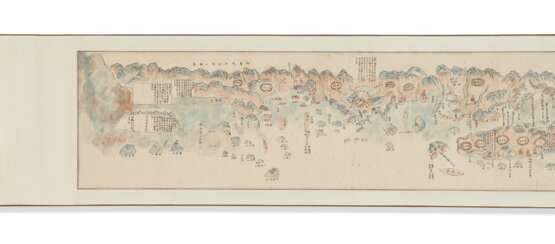ID 627590
Lot 101 | Guangdong Naval Garrison
Valeur estimée
$ 12 000 – 18 000
Manuscript map of Guangdong's naval garrisons in the mid-19th century, depicting from Xuanzhong Port in Zhao’an County in the east, to Jiangping Town in the west, including the Pearl River and its estuary. The Navy of Guangdong was found in 1664, but was dissolved four years later. In 1809, the Navy was re-established, headquartered in the Humen Town. After the First Opium War (1839-1842), naval defense was strengthened along the coasts of Guangdong and Fujian. This map indicates the locations of garrisons and other constructions along Guangdong’s coastlines. The Weiyuan Fort, constructed in 1835, provides a terminus post quem for the map. The small island, originally named “Red Censer,” was renamed “Hong Kong,” and British colonialists began construction on a large scale. What they built on the Censer were no longer Chinese-style buildings, but rather occidental stone structures. This map was very likely drawn before the Second Opium War (1860), since Kowloon was still under the control of the Qing government. The small island drawn north of Hong Kong Island is Kellett Island, where British defensive forts faced the Kowloon peninsula (Chan). This type of map, with depictions of landscape in a manner referencing traditional Chinese painting, is more suitable for the strategic planning conducted by higher-level commanding officers (Liang). This map is a close copy of the original map in the collection of the First Historical Archives of China. References: Libby Lai-Pik Chan, East Meets West - Maritime Silk Routes in the 13th-18th Centuries (2016); Erping Liang, History of Chinese Nautical Charts (2021), pp. 447-449.
Manuscript map of Guangdong coasts in the form of a long handscroll mounted on silk, ink and colors on paper, edged in white silk, with orange-pink silk protective wrapper, rolled on a bamboo roller, approximately 410 x 6250 mm overall, fitting within a 115 x 620 x 115 mm wood box. Text in Chinese, coastlines and mountains outlined in ink, waters colored in pale blue, plains and mountain slopes in ochre, mountain peaks and rock formations in azure blue and greys, numerous houses, temples, prominent pagodas and forts neatly drawn and colored in brown, wall gates, buildings and watch-towers are rendered with articulation. The principal garrisons are denoted by oval-shaped wall constructions with four gates, annotated in Chinese with the names of the garrisons, the number and type of soldiers that can be accommodated, and the distance mileage to neighboring cities. (Mild fading, occasional light staining to the surface and to margins of the silk mountings.)
Exhibited: “The World on Paper: From Square to Sphericity,” Hong Kong Maritime Museum, December 2019 to March 2020.
Please note that this lot is subject to an import tariff. If the buyer instructs Christie’s to arrange shipping of the lot to a foreign address, the buyer will not be required to pay the import tariff. If the buyer instructs Christie’s to arrange shipping of the lot to a domestic address, if the buyer collects the property in person, or if the buyer arranges their own shipping (whether domestically or internationally), the buyer will be required to pay the import tariff. Please contact Post Sale Services on +1 212 636 2650 prior to bidding for more information.
| Artiste: | William Shakespeare (1564 - 1616) |
|---|---|
| Technique appliquée: | Crayon |
| Artiste: | William Shakespeare (1564 - 1616) |
|---|---|
| Technique appliquée: | Crayon |
| Adresse de l'enchère |
CHRISTIE'S 8 King Street, St. James's SW1Y 6QT London Royaume-Uni | |
|---|---|---|
| Aperçu |
| |
| Téléphone | +44 (0)20 7839 9060 | |
| Commission | see on Website | |
| Conditions d'utilisation | Conditions d'utilisation |
















